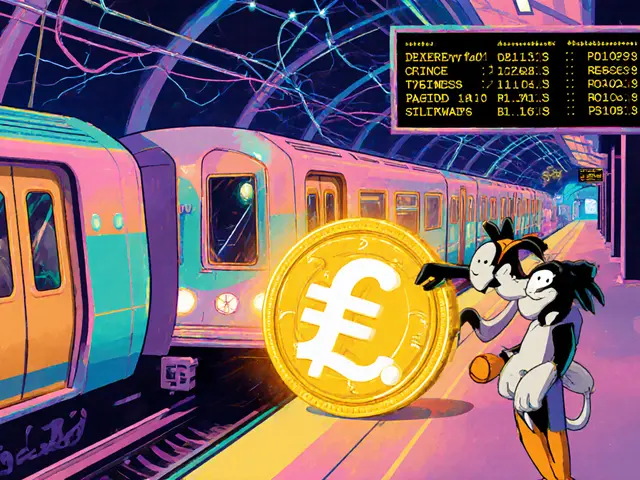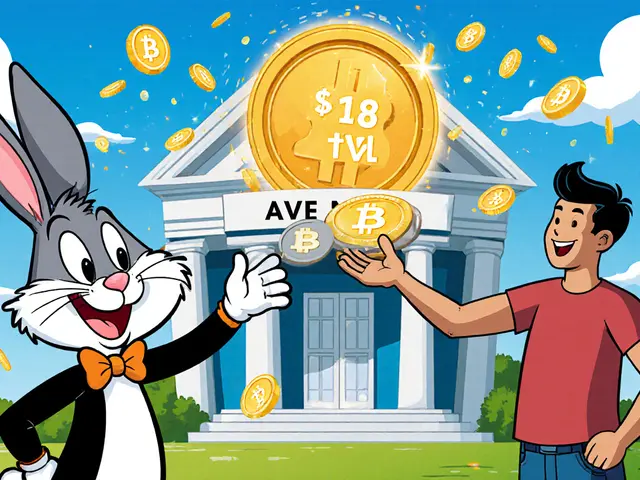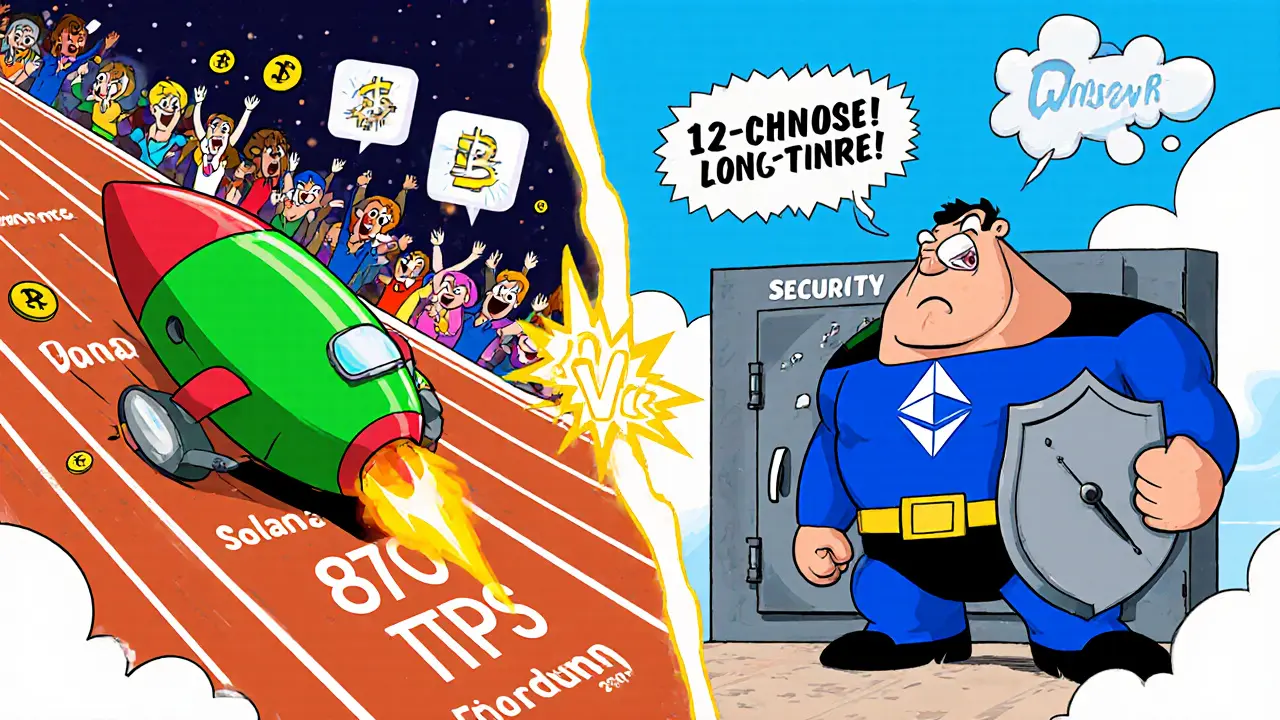
Solana vs Ethereum Transaction Cost Calculator
Estimate Transaction Costs
Calculate the estimated fees for your transactions on both Solana and Ethereum platforms.
Trying to decide which smart‑contract platform fits your next project? You’re probably weighing speed against security, fees against decentralization, or developer tooling against community size. This guide cuts through the hype and lays out the hard facts on Solana vs Ethereum as of October 2025, so you can choose with confidence.
What is Ethereum?
Ethereum is a public blockchain that introduced programmable money through smart contracts. Launched on July 30, 2015 by Vitalik Buterin, it now runs on a Proof‑of‑Stake (PoS) consensus after the September 2022 Merge. The platform processes about 15‑30 transactions per second (TPS) on Layer 1 and hosts roughly 5,000 dApps with over 290 million active addresses (KuCoin Research, 2025). Its security model, massive developer ecosystem, and deep institutional adoption make it the default choice for high‑value DeFi and NFT projects.
What is Solana?
Solana is a high‑throughput blockchain created by Anatoly Yakovenko and launched in March 2020. It combines Proof‑of‑Stake with a unique Proof‑of‑History (PoH) ordering service, enabling sub‑second block times (≈0.39 s) and real‑world throughput around 870 TPS, with peaks above 4,700 TPS (Token Metrics, 2025). As of October 2025 the network runs over 1,940 validators and processes more than 100 million transactions daily, positioning it as a strong contender for speed‑critical apps like NFT drops and on‑chain gaming.
Consensus Mechanisms: PoS vs PoH‑PoS
Ethereum’s PoS relies on validators staking ETH to secure the chain. The design prioritises decentralisation: anyone with the minimum 32 ETH can run a validator on modest hardware (≈2 GB RAM, 2 CPU cores). This low entry barrier underpins its 812,000+ active validators (Beacon Chain Explorer, 2025).
Solana, on the other hand, pairs PoS with PoH, a verifiable delay function that timestamps events before consensus is reached. PoH enables the Proof of History clock, letting validators order transactions without a traditional mempool. The trade‑off is higher hardware demand: validators typically run NVIDIA A100 GPUs and 128 GB+ RAM, which concentrates node operation among a smaller set of operators (Built In, 2025).
Performance and Scalability
When you compare raw numbers, Solana outpaces Ethereum by a wide margin on Layer 1. Real‑world TPS sits near 870 TPS for Solana versus roughly 20 TPS for Ethereum. Theoretic caps are even starker-Solana’s architecture claims up to 65,000 TPS, while Ethereum’s base layer will remain limited even after Proto‑Danksharding (EIP‑4844) rolls out in early 2026.
Ethereum mitigates this gap with Layer 2 solutions. Optimism, Arbitrum, and Starknet collectively push daily throughput past 1.2 million transactions (L2Beat, 2025). However, moving assets onto a rollup adds latency and complexity, which some developers view as a barrier to mainstream user experiences.
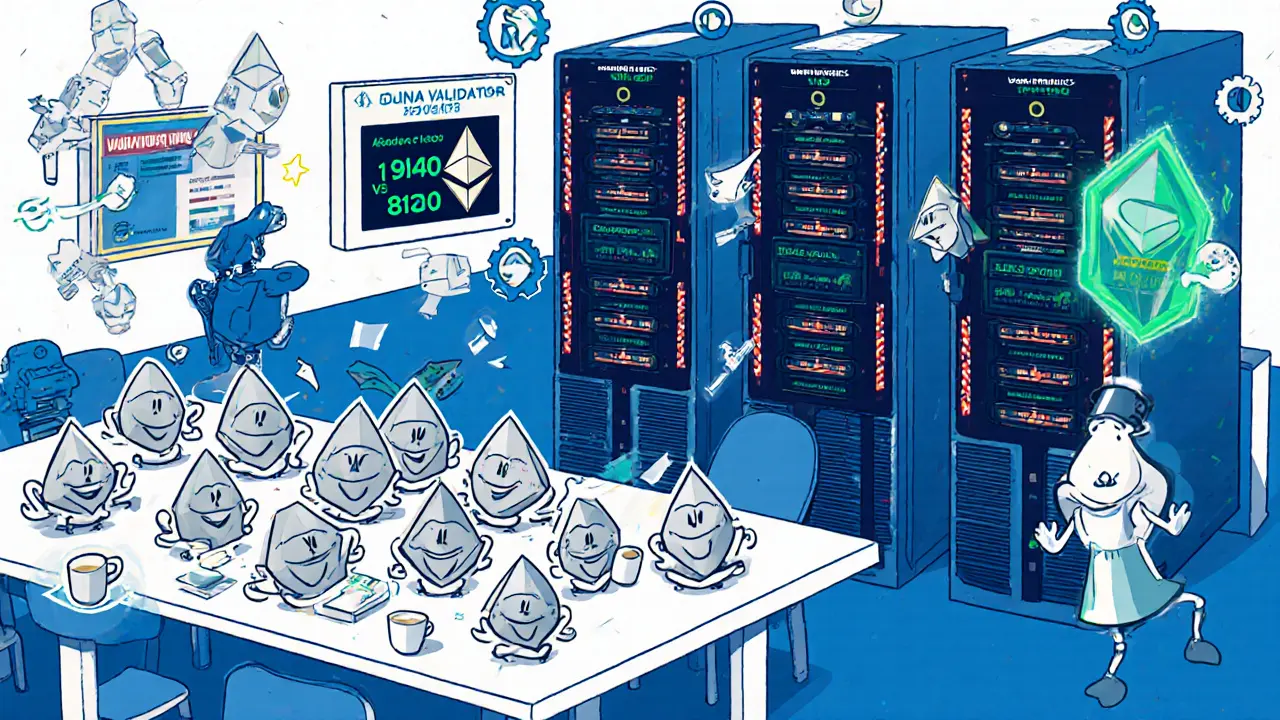
Decentralisation and Validator Landscape
Decentralisation is often measured by validator count and hardware diversity. Ethereum’s 812k validators spread across many geographic regions, reinforcing its claim as the most decentralised smart‑contract platform. Solana’s 1,940 validators, while sufficient for current network stability, concentrate risk in a few high‑spec data centres. Six notable outages in 2024 (totaling 17 hours) underscored these centralisation concerns.
From a staking perspective, yields also differ. As of October 2025 Solana offers roughly 8.0 % APY, whereas Ethereum’s staking reward sits near 3.5 % (Purpose Investments, 2025). Higher yields can attract capital, but they also reflect the higher risk profile of the underlying consensus design.
Transaction Costs and User Experience
Fee structures speak loudly to end‑users. Solana’s average fee is $0.00025 per transaction (SolanaFM, Q3 2025), making micro‑payments and NFT minting practically free. Ethereum’s Layer 1 fee averages $1.27 under normal conditions but can spike above $50 during congestion (Etherscan, Sep 2025). This volatility has driven developers to batch operations or shift to Layer 2, adding implementation overhead.
Real‑world anecdotes illustrate the gap: a Solana user minted 10,000 NFTs for a total of $2.50, while an Ethereum trader once paid $83 in gas to swap $50 worth of tokens during a peak‑demand event. Such experiences shape community sentiment and can influence product‑market fit.
Ecosystem Maturity and dApp Landscape
Ethereum’s ecosystem is deep and diverse. Nearly 5,000 dApps, 290 million active addresses, and a robust DeFi suite (Lido, Uniswap, Aave) dominate institutional usage. Its tooling-Hardhat, Foundry, Remix-covers 68 % of developers (ETHGlobal survey, Q2 2025), and the EVM standardises code across 60+ compatible chains.
Solana’s ecosystem is smaller but growing fast. Over 440 dApps exist, with a strong focus on NFT marketplaces (TensorSwap processes 1.2 million NFT transactions daily) and decentralized exchanges (Jupiter handles $427 million in daily volume). The platform’s developer grants total $42.8 million in 2025, fueling rapid prototype creation, especially in the mobile space (Solana Mobile Stack processed 4.7 million transactions in Q3 2025).
Learning curves differ: Ethereum uses Solidity, which many developers already know, whereas Solana requires Rust-a systems‑level language that 78 % of surveyed developers found challenging before first use (CoinGecko developer survey, May 2025).
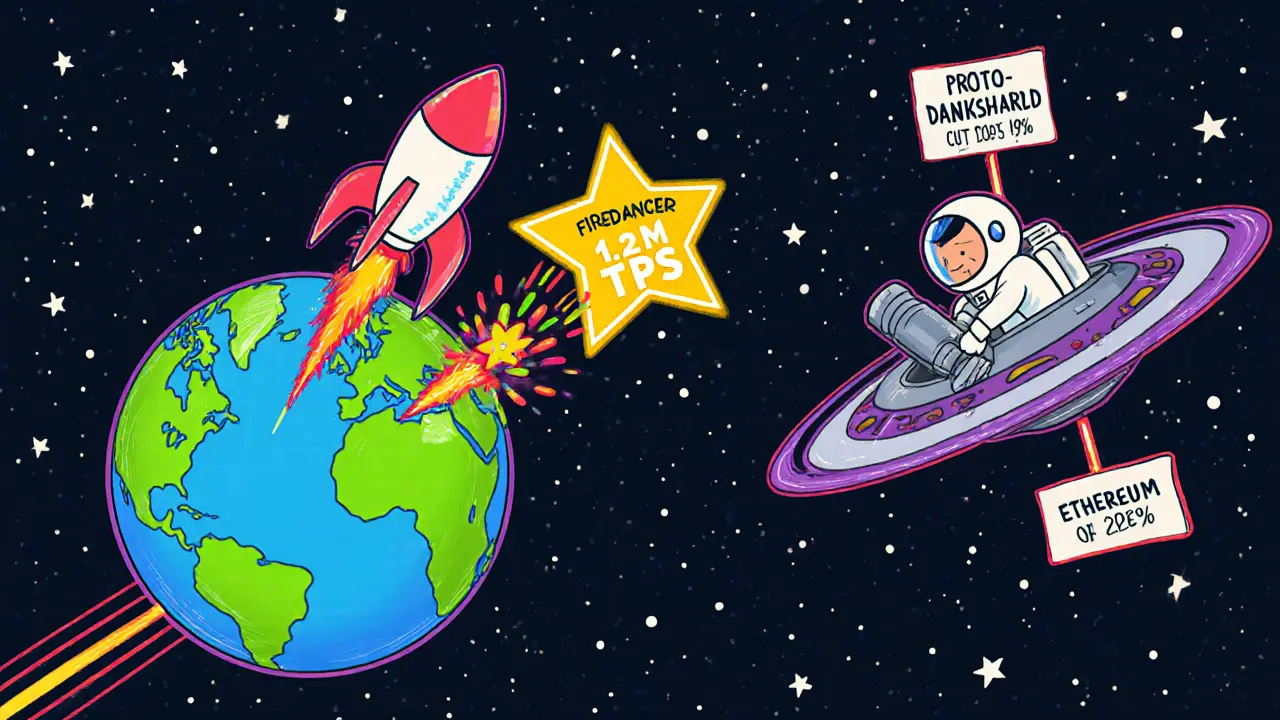
Market Adoption and Financial Metrics
Market caps still favour Ethereum: $312.4 billion versus Solana’s $68.2 billion (CoinMarketCap, Oct 12 2025). Institutional custody solutions support ETH in 78 % of cases (Citi Global Markets, Sep 2025), reflecting trust in security and regulatory compliance.
Conversely, Solana is carving a niche in consumer‑facing applications. Visa reported 12 new payment apps built on Solana in 2025, compared with only three on Ethereum, citing Solana’s low latency for high‑frequency transactions.
Both chains showed price declines in 2025 (Ethereum ‑25 %, Solana ‑19 % from Jan 2025), yet Solana’s lower drop and higher transaction volume suggest resilience in user‑driven markets.
Future Roadmaps: What’s Next?
Ethereum’s next milestone is Proto‑Danksharding (EIP‑4844), slated for Q1 2026, which should cut data‑availability costs for rollups by up to 90 %. Beyond that, Verkle trees (targeted Q3 2026) aim to shrink node storage by 90 %.
Solana is betting on Firedancer, a new validator client from Jump Crypto, promising to boost throughput to 1.2 million TPS by late 2026. QUIC protocol optimisations are also set to slash propagation latency by 50 % before the year ends.
Analysts diverge on long‑term outcomes: Messari (2025) predicts Ethereum will stay the security leader while Solana dominates consumer‑app space; Delphi Digital (Sep 2025) argues Solana’s speed advantage will force Ethereum to adopt comparable architectural changes.
Side‑by‑Side Comparison
| Metric | Solana | Ethereum |
|---|---|---|
| Launch Year | 2020 | 2015 |
| Consensus | PoS + Proof of History | Proof of Stake (post‑Merge) |
| Block Time | ≈0.39 seconds | ≈12 seconds |
| Real‑World TPS | ≈870 TPS (peaks >4,700) | ≈20 TPS |
| Validator Count | ~1,940 | ~812,000 |
| Average Transaction Fee | $0.00025 | $1.27 (spikes >$50) |
| Annual Staking Yield | ~8 % | ~3.5 % |
| Number of dApps | ≈440 | ≈5,000 |
| Active Addresses | ~100 million | ~290 million |
| Market Cap (Oct 2025) | $68.2 billion | $312.4 billion |
Quick Takeaways
- If you need ultra‑low fees and sub‑second finality for consumer‑grade apps, Solana’s architecture delivers today.
- If security, decentralisation, and a massive developer ecosystem matter most, Ethereum remains the safest bet.
- Layer‑2 solutions narrow the speed gap for Ethereum but add architectural complexity; Solana avoids this by scaling on‑chain.
- Validator hardware requirements are a make‑or‑break factor: Solana demands high‑end GPUs, while Ethereum can run on modest cloud instances.
- Future upgrades (Proto‑Danksharding for Ethereum, Firedancer for Solana) will shift the balance, so monitor roadmap milestones if you’re planning long‑term.
Which platform is cheaper for everyday transactions?
Solana’s average fee of $0.00025 makes it dramatically cheaper than Ethereum’s $1.27 average (and occasional $50+ spikes). For micro‑payments, NFT minting, or gaming, Solana is the clear winner.
How does decentralisation compare between Solana and Ethereum?
Ethereum boasts over 800 k validators running on consumer‑grade hardware, giving it a far broader validator distribution. Solana’s ~2 k validators require high‑end GPUs, concentrating stake and raising centralisation concerns.
Can I use existing Solidity code on Solana?
Not directly. Solana contracts are written in Rust (or C/C++) and compiled to BPF. However, the growing SVM (Solana Virtual Machine) ecosystem offers compatibility layers, but they’re not as mature as the EVM.
What are the biggest risks for each chain?
Ethereum’s risk lies in fee volatility and the complexity of moving to Layer 2. Solana’s risk centers on network outages and validator centralisation due to hardware demands.
Which platform has a stronger roadmap for 2026?
Ethereum’s Proto‑Danksharding (Q1 2026) will drastically lower rollup costs, while Solana’s Firedancer client aims for 1.2 million TPS by late 2026. Both are ambitious, but Ethereum’s upgrades focus on decentralisation, whereas Solana pushes raw performance.


